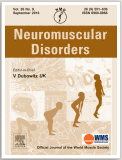 Polyglucosans myopathies are rare muscle diseases characterised by an accumulation of glycogen. Inherited and transmitted in an autosomal recessive mode, they are classified as metabolic myopathies and more precisely, with glycogenosis. In the most frequent case, type IV glycogenosis, a mutation of the GBE1 gene (encoding glycogen branching enzyme), results in a variable deposit of glucosan-like bodies. The clinical consequence is very diverse, often with early liver damage. Nevertheless, there are forms with almost exclusive muscular expression.
Polyglucosans myopathies are rare muscle diseases characterised by an accumulation of glycogen. Inherited and transmitted in an autosomal recessive mode, they are classified as metabolic myopathies and more precisely, with glycogenosis. In the most frequent case, type IV glycogenosis, a mutation of the GBE1 gene (encoding glycogen branching enzyme), results in a variable deposit of glucosan-like bodies. The clinical consequence is very diverse, often with early liver damage. Nevertheless, there are forms with almost exclusive muscular expression.
In an article published in October 2016, French clinicians described the original case of a 3-year-old child with neonatal arthrogryposis associated with delayed motor acquisitions and rigid spine syndrome. Born of a consanguineous union, he was the only one affected in the family. Muscle biopsy was very valuable in demonstrating polyglucosan deposits. Magnetic resonance imaging provided interesting insights into the distribution of muscle atrophy. The subsequent identification of two pathogenic mutations in the GBE1 gene confirmed the diagnosis. The authors consider that this gene should now be studied when any severe childhood retractile myopathy cannot be demonstrated.
